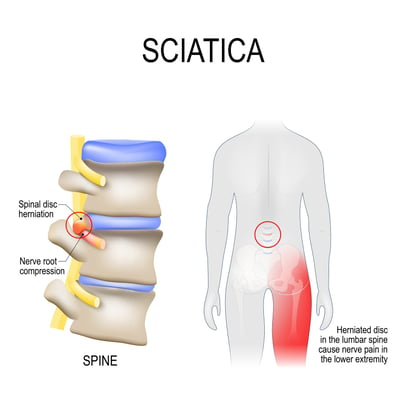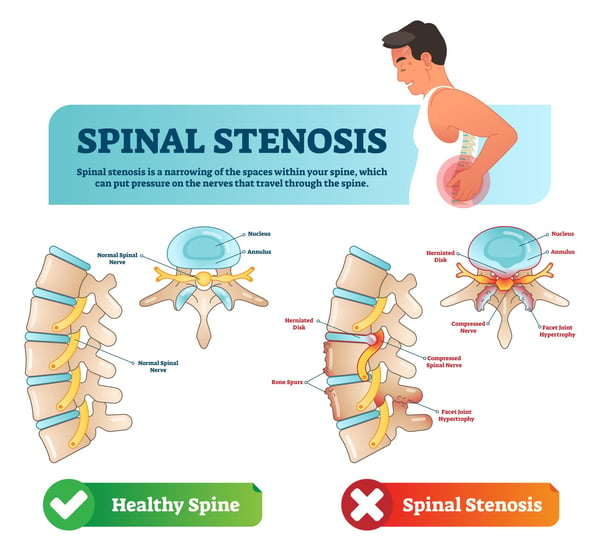 Are you struggling with recurring pain on the outer side of your foot? While this may come as a surprise, pain on the outer side of the foot may actually signal a spinal problem resulting in painful compression of the sciatic nerve.
Are you struggling with recurring pain on the outer side of your foot? While this may come as a surprise, pain on the outer side of the foot may actually signal a spinal problem resulting in painful compression of the sciatic nerve.
The sciatic nerve is one of multiple spinal nerves—five to be exact—that travel from the lower spine into the buttocks, down the legs and into the feet. If any of your spinal nerves are compressed, you may experience pain or other symptoms such as pain shooting down the leg, numbness, weakness, or pain on the outer side of your foot as a result.
More specifically, compression of the S1 nerve root can cause pain along the outer side of the foot, which is often referred to as “classic sciatica.” The specific location of your pain is directly correlated with the disc level and associated nerve root that’s being compressed or “pinched.” For instance, pain on the top or bottom of the foot (as opposed to the outer side) may be indicative of a different nerve root being compressed.
This article explores the underlying causes of nerve root irritation, as well as the signs and symptoms that may indicate sciatica and how to manage them.
Breaking Down the Underlying Causes of Nerve Root Irritation
First, let’s review the different underlying causes of nerve root irritation. If you’re experiencing pain on the outer side of your foot, it may be caused by nerve root irritation due to one of the following spinal conditions:
Lumbar herniated disc
Lumbar disc herniation occurs when pressure or stress placed on the spine causes disc fragments to push through the outer portion of the disc and compress the surrounding spinal nerves. This often results in shooting pain in the buttock, down the leg and into the foot. In more extreme cases, lumbar disc herniation may cause loss of bladder and/or bowel function, the feeling of “pins and needles” in the legs and/or feet, and pain that worsens during movement.

Degenerative disc disease
Degenerative disc disease (DDD) is an age-related condition caused by wear and tear of the spine over time, which results in the shrinking, drying out, and narrowing of the lumbar discs. This often leads to a significant loss in disc height, which can ultimately increase the risk of lumbar disc herniation.
Lumbar spinal stenosis
Lumbar spinal stenosis occurs when the openings for the spinal nerves and spinal cord are very narrow, which puts pressure on the nerves that travel throughout the spine, down the leg, and into the foot. While some don’t experience symptoms due to spinal stenosis, others experience pain, tingling, numbness, and muscle weakness that worsen over time. 
Spondylolisthesis
Spondylolisthesis is a spinal condition in which a lumbar disc slips over the one below it, causing significant discomfort in more severe cases. Persistent lower back pain, stiffness in the back and legs, thigh pain, and pain on the outer side of the foot can all be caused by severe cases of spondylolisthesis.
Other causes of foot pain
There are also other, non-spinal issues that can cause pain on the outer side of the foot, such as damage, dysfunction, or compression of the sciatic, peroneal, or tibial nerves. Examples include:
- Peroneal neuropathy, or a condition that occurs when compression of the peroneal nerve near the knee causes foot pain.
- Sciatic neuropathy, or damage to the sciatic nerve in the hip, which causes pain on top of the foot and some degree of muscle weakness.
- Sural nerve entrapment, or a condition that occurs in the leg or near the ankle, can cause shooting pain on the outer side of the foot and/or ankle.
- Tarsal tunnel syndrome, or dysfunction of the tibial nerve located within the tarsal tunnel of the inner ankle, often causes sharp, shooting pain in the ankle and along the sole of the foot.
- A corn may develop on the skin around your toes and compress nearby nerves, causing painful and frustrating symptoms.
- Morton’s neuroma, a painful condition that impacts the ball of your foot, can also cause pain in the foot.
A physician can identify the source of your foot pain and best treatment approach based on your symptoms, as well as the spinal disc level where your pain is occurring.
Sciatica Symptoms, Warning Signs, and Tips to Minimize Pain
Sciatica, or pain radiating down your leg and into the ankle and foot, is caused by compression of the nerve roots. In addition to pain on the outer side of the foot, sciatica resulting from S1 nerve root compression may also be accompanied by pain, numbness, and weakness in the leg.
In most cases, sciatica affects one leg and foot at a time; however, it’s possible for sciatica to occur in both legs depending on the location of the compressed nerve. You may also experience foot drop, or the inability to lift the front of your foot, also as a result of compression of the nerve roots.
Sciatica can be debilitating and frustrating, but there are certain steps you can take to effectively minimize your foot and leg pain:
- Yoga and stretching
- Regular exercise
- Relaxation techniques
- Hot and cold packs
- Pain medications
- Injection therapy
- Acupuncture
Of course, these tips are not a replacement for a consultation with a physician. If you’re experiencing pain on the outside of your foot—or anywhere for that matter—seeing a specialist is the best next step. A doctor will be able to evaluate your symptoms, conduct the appropriate tests, and make a diagnosis. If more conservative, nonsurgical treatment options are unsuccessful, and a diagnosis of a herniated or bulging disc is confirmed, lumbar discectomy surgery for sciatica may be necessary to reduce your symptoms and improve your condition.
Seeking Expert Help to Achieve Lasting Pain Relief
As you can see, there are several spinal conditions (as well as other conditions unrelated to the spine) that can cause pain on the outer side of your foot. If you’re diagnosed with a spinal condition, your doctor will assess your symptoms and make a recommendation on whether you should pursue conservative treatment or surgery to relieve your pain.
While this blog is meant to provide you with information you need to make an informed decision about your treatment options, it is not intended to replace professional medical care or provide medical advice.
The Barricaid device is designed to prevent reherniation following lumbar discectomy surgery. If you have any questions about the Barricaid, please call or see your doctor, who is the only one qualified to diagnose and treat your spinal condition. As with any surgical procedure, you should select a doctor who is experienced in performing the specific surgery that you are considering.
For additional information, please visit www.barricaid.com. For complete risk-benefit information: www.barricaid.com/instructions-for-use.




Comments